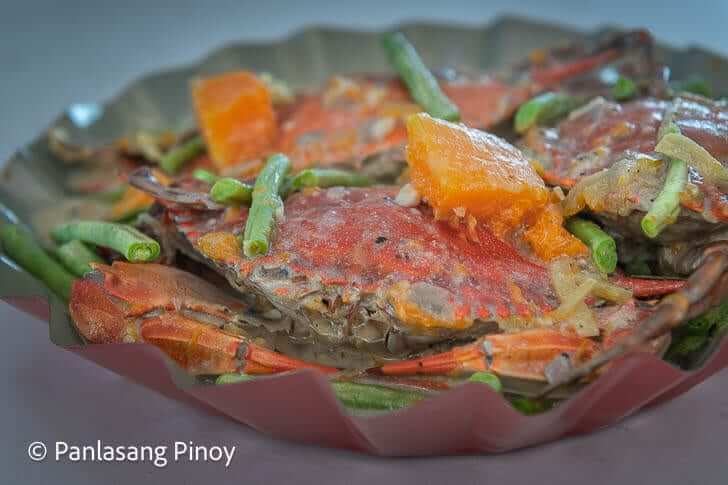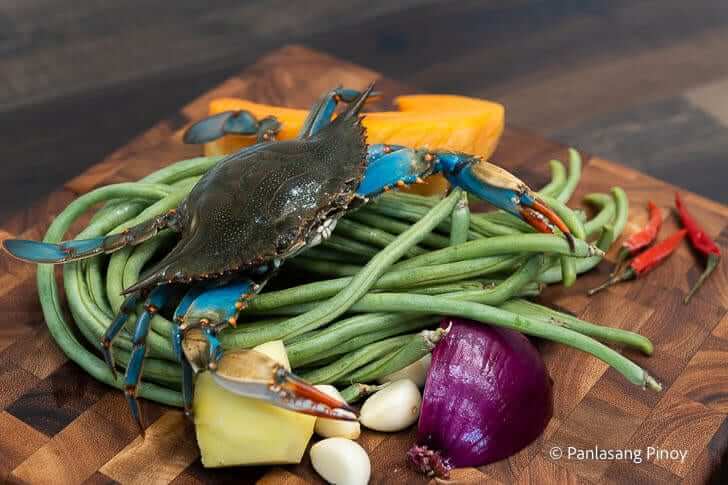Ginataang Alimasag with Sitaw at Kalabasa
The phrase “Ginataang Alimasag” refers to crabs cooked in sweet, tasty coconut milk. Filipinos love anything with gata or coconut milk –– you could say we go nuts for coconuts! It’s one of our most abundant produce, especially since we live in a tropical country. We love coconut juice at the end of a long day because of its refreshing flavor. The “meat” you can scrape from its shell makes for an additional treat! But gata and its warm, sweet, nutty flavor is always a sure favorite with whatever meat, seafood, or veggies you choose to pair it with.

The Ginataang Alimasag recipe I’m using today uses the Knorr Ginataang Gulay Mix instead of authentic coconut milk. This works just as well for those who are on a budget but still want the delicious creaminess gata can provide. The mix comes with a complex flavor palette that pairs perfectly with your crab and vegetables.
Our Ginataang Alimasag recipe for today will also include sitaw (or snake beans) and kalabasa (or squash). Ginataang kalabasa is already a fairly popular and humble dish, but the addition of alimasag makes the taste even richer. And who doesn’t love the tasty, subtly sweet flavor of crab?
If you’re a big fan of shellfish, you might end up liking these dishes, too:
Relleno refers to any kind of meat, chicken or fish, that’s stuffed with a variety of ingredients. Rellenong Alimasag takes vegetables like carrots and potatoes, combining them with crab meat for some fried, flavorful goodness. I like this dish best with banana ketchup or homemade sweet and sour sauce.
Halabos na Alimasag is another way of enjoying this delicious seafood. Halabos means cooking ingredients like crabs or shrimps in a pan and letting it stew in its own juices. With just salt and water, it’s easy to bring out the sweet, natural flavor of the crabs.
But if you want to keep the flavor of crabs in coconut milk, I have recipes that can switch out the vegetables used in this Ginataang Alimasag dish.
Ginataang Langka with Alimasag makes use of unripe jackfruit and malunggay for that extra heat and flavor. Jackfruit’s strong taste pairs well with the sweet and complex taste of the Ginataang Alimasag.
But even without the jackfruit, Ginataang Alimasag with Malunggay makes just as filling and tasty a meal! Malunggay (or Moringa) is not only one of the most delicious vegetables out there, but it’s also the most nutritious. And paired with squash and these meaty crabs, what’s not to love?
Are you the type to like an extra spice? This Ginataang Alimasag with spinach and Thai chilies would be perfect for you! Dishes like this are extra satisfying for your tummy; you’ll be needing lots of white rice to accompany this one.
Cooking seafood might seem daunting at first, but don’t fret –– in just a few steps, you’ll have this at your dinner table in no time at all! Ginataang Alimasag is always an easy way to enjoy delicious crabs from the comfort of your own home.

Try out this awesome Ginataang Alimasag with Sitaw at Kalabasa today.
How to Make Ginataang Alimasag with Sitaw at Kalabasa
The first step to your Ginataang Alimasag is to, of course, prepare all your ingredients before actual cooking time. Steam your 3 crabs for 12 minutes, and while doing so chop, cube, and slice all of your other ingredients. Cut your snake beans into 2 inch pieces, cube your kalabasa (or squash), mince your ginger. Lastly, don’t forget to chop your onion and garlic, crushing the latter.
Once you’ve done all of that, the real cooking begins! Heat your cooking oil in a pan. Saute your garlic, onion, and ginger, until the onion becomes translucent. Combine 2 ½ cups of room temperature water and 40 grams of Knorr Ginataang Gulay Mix, and stir. Make sure these two are well blended before pouring the mixture into your pan. Let it boil.
Now is the time to add in your crab and kalabasa. Cover the pan, letting the mixture boil for five more minutes. Once the time is up, add in your snake beans (or sitaw) and let it cook for eight more minutes. By now, the smell of gata, crab, and vegetables together should be absolutely delicious –– impossible to resist!

Season your Ginataang Alimasag with salt and pepper to taste, but only if you think it needs that extra flavor. But if you’re satisfied with your mixture from the get go, after the eight more minutes your Ginataang Alimasag is ready to serve! Transfer it to a serving bowl for your whole family to share. With a warm cup of white rice, you have a delicious meal everyone will enjoy!
Let us know what you think of the Ginataang Alimasag with Sitaw and Kalabasa!
Ginataang Alimasag with Sitaw at Kalabasa
Blue crabs cooked in coconut milk with snake beans and calabaza squash.
Ingredients
- 3 pieces crab steamed for 12 minutes
- 40 grams Knorr Ginataang Gulay Recipe Mix
- 15 pieces snake beans cut into 2-inch pieces
- 12 ounces calabaza squash cubed
- 1 piece onion chopped
- 2 thumbs ginger minced
- 5 cloves garlic crushed and chopped
- 3 tablespoons cooking oil
- 2 1/2 cups water room temperature
- Salt and ground black pepper to taste optional
Instructions
-
Heat oil in a pan.
-
Saute garlic, onion, and ginger until onion turns translucent.
-
Combine water and Knorr Ginataang Gulay Mix. Stir until well blended. Pour mixture into the pan. Let boil.
-
Add crab and kalabasa. Cover and boil for 5 minutes.
-
Add snake beans. Continue cooking for 8 minutes.
-
Season with salt and pepper if desired. Note: this is an optional step.
Nutrition
Calories: 376kcal | Carbohydrates: 59g | Protein: 12g | Fat: 16g | Saturated Fat: 2g | Trans Fat: 1g | Cholesterol: 1mg | Sodium: 58mg | Potassium: 1698mg | Fiber: 22g | Sugar: 21g | Vitamin A: 5228IU | Vitamin C: 80mg | Calcium: 454mg | Iron: 11mg
Watch How to Cook Blue Crab in Coconut Milk
[embedded content]
